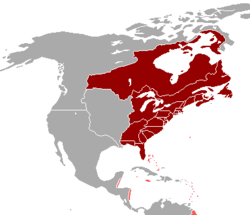Amẹ́ríkà Brítánì
| Àyọkà yìí únfẹ́ ìyílédèdà sí Yorùbá. Ẹ ran Wikipedia lọ́wọ́ ṣàtúnṣe sí ìyílédèdà |
British America is the anachronistic term used to refer to the territories under the control of the Crown or Parliament of the United Kingdom in present day North America (including Bermuda), Central America, the Caribbean, and Guyana. Colonial America consisted of the English and later British Empire in continental North America in the 17th and 18th centuries. Formally, the British Colonies in North America were known as British America[1] and the British West Indies until 1776, when the Thirteen British Colonies located along the Atlantic seaboard declared their independence and formed the United States of America. After that, British North America (or, simply but not inclusively, Canada) were used to describe the remainder of Britain's continental North American possessions. The term "British North America" was first used informally in 1783, but it was uncommon before the Report on the Affairs of British North America (1839), called the Durham Report.
British America gained large amounts of new territory following the Treaty of Paris which ended Britain's involvement in the Seven Years' War. At the start of the American War of Independence in 1775, the British Empire included 20 colonies north and east of New Spain (Present day areas of Mexico and the Western United States). East Florida and West Florida were ceded to Spain in the Treaty of Paris (1783) which ended the American Revolution, and then ceded by Spain to the United States in 1819. All but one of the remaining colonies of British North America apart from the British West Indies united together from 1867 to 1873 forming the Dominion of Canada. Newfoundland joined Canada in 1949.

|
Àyọkà yìí tàbí apá rẹ̀ únfẹ́ àtúnṣe sí. Ẹ le fẹ̀ jù báyìí lọ tàbí kí ẹ ṣàtúnṣe rẹ̀ lọ́nà tí yíò mu kúnrẹ́rẹ́. Ẹ ran Wikipedia lọ́wọ́ láti fẹ̀ẹ́ jù báyìí lọ. |
Itokasi
[àtúnṣe | àtúnṣe àmìọ̀rọ̀]- ↑ "A Summary View of the Rights of British America – [[Thomas Jefferson]]". URL–wikilink conflict (help)


